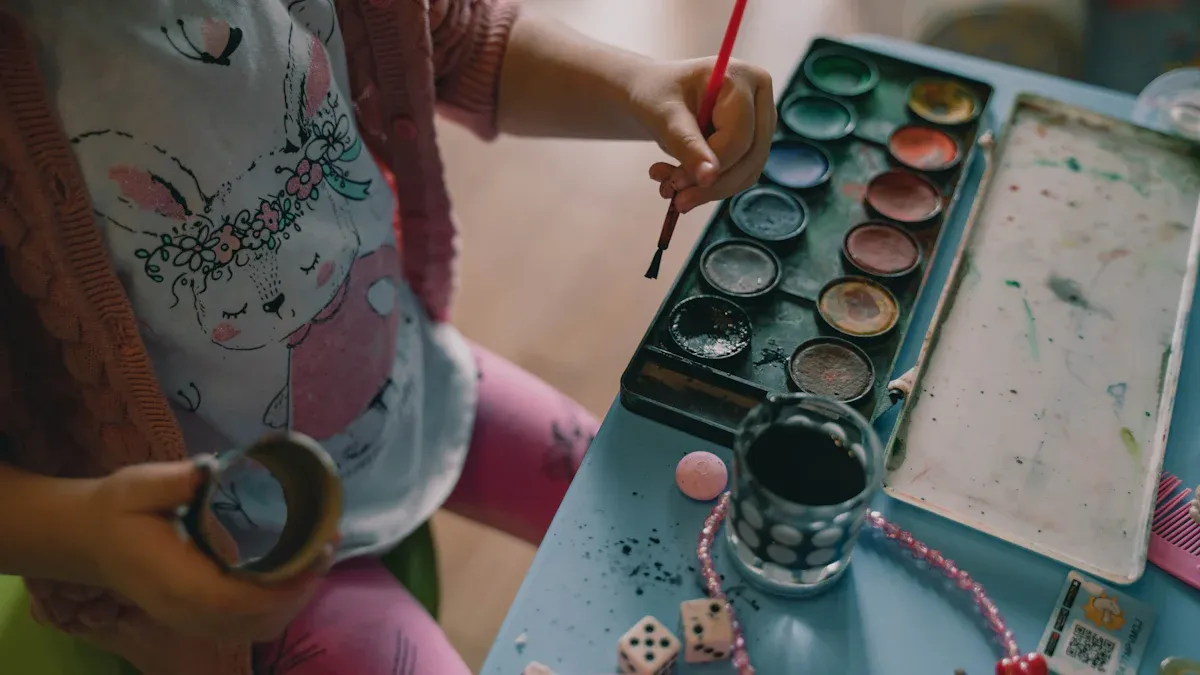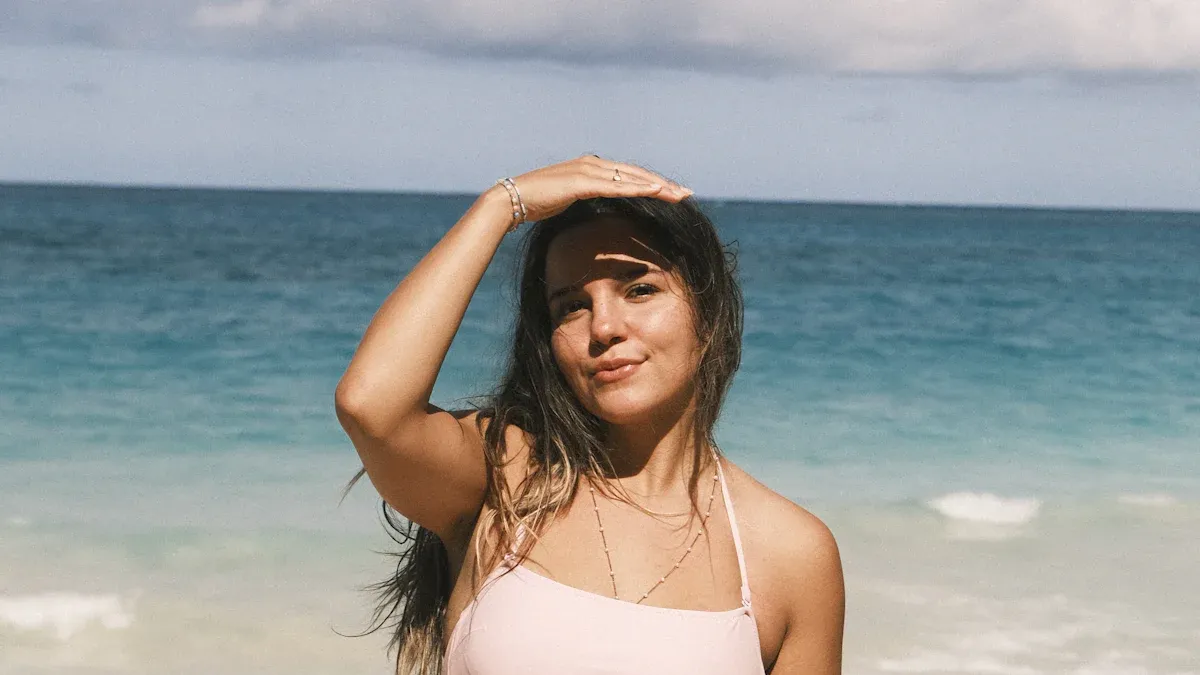
Sampling helps answer an important question in swimwear manufacturing: does the swimwear fit well, look good, and have good quality? A custom swimwear manufacturer uses samples to check every part before making a lot of swimwear. Physical samples let the manufacturer and client see the swimwear, touch the fabric, and look at the design in person. Sampling in swimwear manufacturing finds problems early, so teams can fix them and make high-quality swimwear that matches the first design idea.
Key Takeaways
Sampling lets swimwear makers see if things fit well. It helps them check the design and quality before making a lot.
There are different sample types like prototypes and fit samples. These let teams test swimwear and make it better step by step.
Samples use real swimwear fabrics. This makes sure the swimwear feels good, lasts long, and fits right in real life.
Clients look at samples early. This way, problems get fixed before making many pieces. It helps keep the quality high.
Careful sampling means fewer mistakes. It helps customers trust the brand. It also makes swimwear better and last longer.
Sampling in Swimwear Manufacturing
What Are Samples?
Samples are early versions of swimwear designs. Manufacturers make these using the chosen fabrics and trims. The goal is to turn a design idea into something real. Samples let people test and look at the swimwear. Both the manufacturer and client can check how it fits and looks. They can also see if it feels comfortable. Using real swimwear fabrics helps the team see how the fabric stretches and feels. They can test how it works in different situations.
Samples are very important in making swimwear. They help brands and clients find problems with the design or fabric. This happens before making lots of swimwear. This step makes sure the final swimwear is good quality and stylish.
Manufacturers use samples to: 1. Make sure the design, fit, and quality are right. 2. Get feedback and improve things before making more. 3. Let buyers look at and approve the swimwear. 4. Start the whole manufacturing process. 5. Find and fix problems with fabrics and how it’s made. 6. Figure out costs and plan when to deliver. 7. Show good samples to get more orders. 8. Fix issues that come up when making lots of swimwear. 9. Let buyers check fabric, color, fit, and materials for quick changes.
Types of Samples
Swimwear makers use different samples to test each part of the product. Each sample has its own job. The table below shows the main types and what they do:
Sample Type | Purpose |
|---|---|
Checks the first design and fabric choice. | |
Fit Sample | Works on getting the fit right for all sizes. |
Pre-production Sample | Is the final version before making lots of swimwear. |
Manufacturers use these samples to see how fabrics act and how the design looks on people. They also check how the fabric feels when dry or wet. By looking at each sample, the team can change patterns and materials. They can also fix how the swimwear is made. This careful work makes sure the final swimwear is good in every way. Testing with real fabrics helps brands avoid big mistakes. It also helps them make swimwear that customers will like.
Importance for Custom Swimwear Manufacturer
Fit and Comfort
A custom swimwear manufacturer uses sampling to make sure each piece fits well and feels good. They make samples with real swimwear fabrics. Then, they ask expert reviewers to try the swimwear in real-life situations. Reviewers with different body shapes wear the swimwear and give feedback about fit, coverage, support, and how easy it is to use. These tests help find comfort problems that lab tests might miss. Sampling also lets the manufacturer check if the swimwear lasts after being worn and washed many times. By getting feedback from many testers, the manufacturer can change patterns and fabrics to make the swimwear more comfortable for everyone.
Expert reviewers try on swimwear samples and test them.
They check fit, feel, coverage, support, and comfort over time.
Reviewers with different body types give their opinions.
Real-life testing finds comfort problems not seen in labs.
Sampling checks if swimwear stays strong after many washes.
Sampling helps the manufacturer make swimwear that is comfortable and fits well. This lowers the chance of unhappy customers and returns.
Design and Fabric Testing
Sampling is very important for turning design ideas into real swimwear. The manufacturer makes samples that focus on shape, fit, how they are made, and stitching. They use chosen swimwear fabrics to make patterns that are correct, often quickly and with no minimum order. Designers can buy ready-made designs online or ask for custom ones by sending tech packs or pictures. The manufacturer can use CAD files to make patterns exactly.
During sampling, the manufacturer finishes labels, packaging, and extras to avoid delays later. Custom prints are made and approved with digital pictures and test swatches. Size guides are given and changed to fit the right customers. Samples are sent out fast for checking.
The sampling process has several steps:
Design and Fabric Selection: Designers draw ideas and pick fabrics, which can be changed.
Pattern Making: Patterns are made by hand or with CAD to get the right shape and fit.
Sample Garment Production: Swimwear fabrics are sewn into samples, sometimes more than once.
Function Testing: Samples are tested for stretch, water resistance, chlorine resistance, and how fast they dry.
Feedback and Modification: Changes are made after testing and fitting to make the design better.
Mass Production: When samples pass all tests, the manufacturer starts making lots of swimwear using the final sample.
Careful design and fabric testing during sampling gives clear results. The manufacturer checks GSM to see fabric weight and how it hangs, which changes how it feels and fits. They test how strong the fabric is and if it tears easily. They check if the swimwear can handle rubbing. They also test how well it manages moisture for comfort. Durability and color tests make sure the swimwear stays nice over time. Feedback about fit and comfort helps improve the design and fabric. Quality checks during production keep standards high and stop mistakes.
Sampling makes sure the swimwear matches the design plan, keeps products the same, and stops problems in production. This helps swimwear work better and makes customers happy.
Client Approval
Client approval is an important step in making swimwear. The manufacturer makes first samples that show the design. Clients look at these samples to check quality, fit, and if the design is right. Their feedback can lead to changes, making sure the sample is what they want before making more.
The sampling step makes first swimwear samples that show the design.
Clients check samples for quality, fit, and design.
Client feedback can lead to changes during sampling.
Approval happens in steps to make sure the sample is right.
Fixing problems early makes the final swimwear better.
The final swimwear is made using the approved sample, so it is always the same and good quality.
This way, the manufacturer can fix problems early and make the final swimwear better and more consistent. The approved sample is used as the model for making lots of swimwear, helping the manufacturer meet client needs and keep quality high.
Sampling Process Steps

Design to Prototype
Making swimwear starts with a clear idea. Designers draw sketches and pick colors and trims. These choices show what the brand is about. Next, they find swimwear fabrics that look good and work well. The team makes patterns using CAD software for the right shape and fit.
Manufacturers use a step-by-step process to make a prototype:
Designers make sketches and pick fabrics and colors.
They find fabrics that stretch and last for swimwear.
A prototype, or toile, is made to check fit and size.
Models wear the prototype to test comfort and movement.
The team tests stretch, chlorine resistance, and color staying power.
They keep changing the prototype until it matches the plan.
The team uses real swimwear fabrics at this stage. They check if the fabric stretches well and blocks light. They also test if it stands up to chlorine and sunlight. This careful work helps the team stay on track. It makes sure the prototype looks and works like the final swimwear.
Fit Samples
Fit samples are very important in making swimwear. These samples help the team see how swimwear fits different people. Designers, experts, and models work together in fit sessions. They look for problems like tightness or if it feels bad to wear.
Models try on swimwear and talk about comfort and support.
The team checks if sizes and shapes are correct.
Real swimwear fabrics are used to see how it acts in water.
Fit samples help stop returns and make customers happy. By testing with real fabrics, the team can fix patterns and how it is made. This step makes sure the swimwear feels good and works well for buyers.
Tip: Fit samples often show small problems early. Fixing these now saves time and money later.
Revisions and Final Samples
After fit testing, the team looks at all feedback and makes changes. They fix patterns, change how things are made, and pick the final fabrics. The manufacturer then makes a final sample, which is the best version for making lots of swimwear.
Prototypes let the team try new ideas, but final samples show the finished product.
Factories use the same fabrics, trims, and hardware for the final sample as for mass production.
The team checks every part, like stitching and seam strength.
Final samples go through tough quality checks to meet standards.
Final samples are better than first prototypes in quality and details. The last sample uses the chosen swimwear fabrics and all design fixes. This sample is the main guide for making all swimwear. The factory only starts making lots of swimwear after the client says yes to the final sample.
Note: The final sample makes sure every piece is the same and good quality. This keeps the brand strong and customers happy.
Sampling Benefits and Challenges
Benefits for Swimwear Brands
Sampling gives swimwear brands a big advantage. Brands can test fit, comfort, and strength before making many pieces. This helps them avoid expensive mistakes and keeps quality high. Sampling also helps brands pick the best fabrics and trims. By using real samples, brands check if swimwear works in water, keeps color, and stays in shape. This step helps customers trust the brand and makes the brand known for good quality.
Brands that use sampling often have fewer returns and happier customers. They can also try out eco-friendly materials and make their collections better for the planet.
Common Challenges
Swimwear sampling has some problems that brands must solve:
Picking the wrong material can cause fading, stretching, or weak spots.
Getting the right fit and comfort is hard and can cause rubbing.
Keeping colors bright in chlorine, saltwater, and sun is tough.
Weak seams can come apart or lose their shape.
Brands need rules to check quality for all styles and sizes.
Good sampling and testing help find problems early.
Choosing the wrong maker or only caring about price can hurt the business.
Bad tech packs and missing trends can make samples fit badly and not sell.
Solutions and Best Practices
Top swimwear brands use smart ways to fix these problems:
Pick makers who know swimwear, especially those who use eco-friendly and strong fabrics.
Ask for samples to check quality, fit, sewing, and strength before big orders.
Talk about order size and payment to lower risks, sometimes by working with other brands or swapping materials.
Keep talking with makers to set clear rules for quality and timing.
Watch production by checking, visiting factories, or using outside help.
Build good relationships with trusted makers to get better deals and smooth work.
Make and test samples well before making lots to be sure of quality and fit.
Brands that pick good and eco-friendly fabrics when buying see better swimwear and help the planet. Checking quality often and getting feedback keeps standards high during making.
Impact on Product and Reputation

Quality Assurance
Swimwear brands use sampling to keep their products high quality. Sampling lets brands test designs, fabrics, and how things are made before making a lot. Some brands, like Bali Swim, let new companies order samples with no minimum. This helps new brands try out ideas without risk. It also makes product development easier and helps the final swimwear match what the brand wants.
Quality assurance has many steps:
Brands use first samples to find and fix problems.
Fit tests with models check comfort and sizing.
Fabric tests look at stretch, strength, and color after sun and chlorine.
Brands check big orders for stitching, fabric, and size.
Brands talk with makers to solve problems fast.
Quality Assurance Measure | Description |
|---|---|
Component Verification | Checks elastics, trims, and hardware for correct size and cutting. |
Fit Tests | Looks at elastic tightness, fabric bounce-back, and comfort. |
Final Inspection | Uses AQL rules to check for mistakes and packaging. |
Colorfastness Testing | Makes sure colors last in chlorine, saltwater, and sunlight. |
Defect Rate Monitoring | Watches for mistakes during making and checking. |
Brands do many rounds of sampling and fit tests. They compare samples to technical rules and change things if needed. This makes sure swimwear is good before making a lot. These steps help brands get fewer returns and make customers trust them.
Customer Satisfaction
Sampling helps swimwear brands make customers happy. Brands use fabric checks to keep base fabric and patterns the same in every batch. They keep extra fabric and records to answer customer questions fast and track changes. Careful testing checks color, UV, and chlorine resistance before making lots of swimwear. This stops returns and complaints and makes sure swimwear meets what customers want.
Aspect | Description | Impact on Customer Satisfaction |
|---|---|---|
Makes sure fabric and patterns stay the same in every batch. | Stops quality problems so customers get matching swimwear. | |
Fabric Backups | Keeps extra fabric and records for quick changes. | Helps with fast orders and fixes, building trust. |
Functionality Testing | Checks color, UV, and chlorine resistance. | Stops returns by making swimwear strong and lasting. |
Case Example | Customer bought again and got a perfect match because of backups. | Shows how sampling and backups keep quality and trust high. |
New sampling tools like 3D virtual models and AI help brands work faster and better. These tools save fabric and speed up making samples. They also help brands make swimwear that fits well, which makes customers loyal. Working together online helps teams decide quickly and try new ideas. Because of this, brands get better products, happier customers, and a stronger name. Brands that care about quality and the planet build trust and keep customers for a long time.
Sampling is very important for making good custom swimwear. Brands that do careful sampling get many benefits over time:
They check the fabric, how it is made, and the design before making lots of swimwear. This makes sure every piece is what people want.
Testing things like UV protection and fast-drying fabric helps the swimwear be special.
Sampling helps stop mistakes and problems that cost money.
It helps manufacturers and clients work together better, so the swimwear turns out great.
Sampling helps people trust the brand, makes customers happy, and makes the brand stronger.
Custom swimwear makers who focus on sampling can do well for a long time.
FAQ
What is the main purpose of sampling in swimwear manufacturing?
Sampling lets brands check if swimwear fits and looks good. Teams use samples to find problems before making many pieces. This helps make sure the final swimwear is what brands and buyers want.
How many samples does a swimwear brand usually need?
Most brands need three main samples: a prototype, a fit sample, and a pre-production sample. Some brands might want more samples for special sizes or custom parts.
Why do manufacturers use real swimwear fabric for samples?
Manufacturers use real swimwear fabric to test how it stretches and feels. This helps teams see if the swimwear works well in water and after washing.
Can clients request changes after seeing a sample?
Yes, clients can ask for changes after looking at a sample. Manufacturers use this feedback to change patterns, fabrics, or small details before making a lot.
How does sampling help reduce returns?
Sampling lets brands test fit and quality with real people. Fixing problems early means fewer unhappy buyers and fewer returns.
